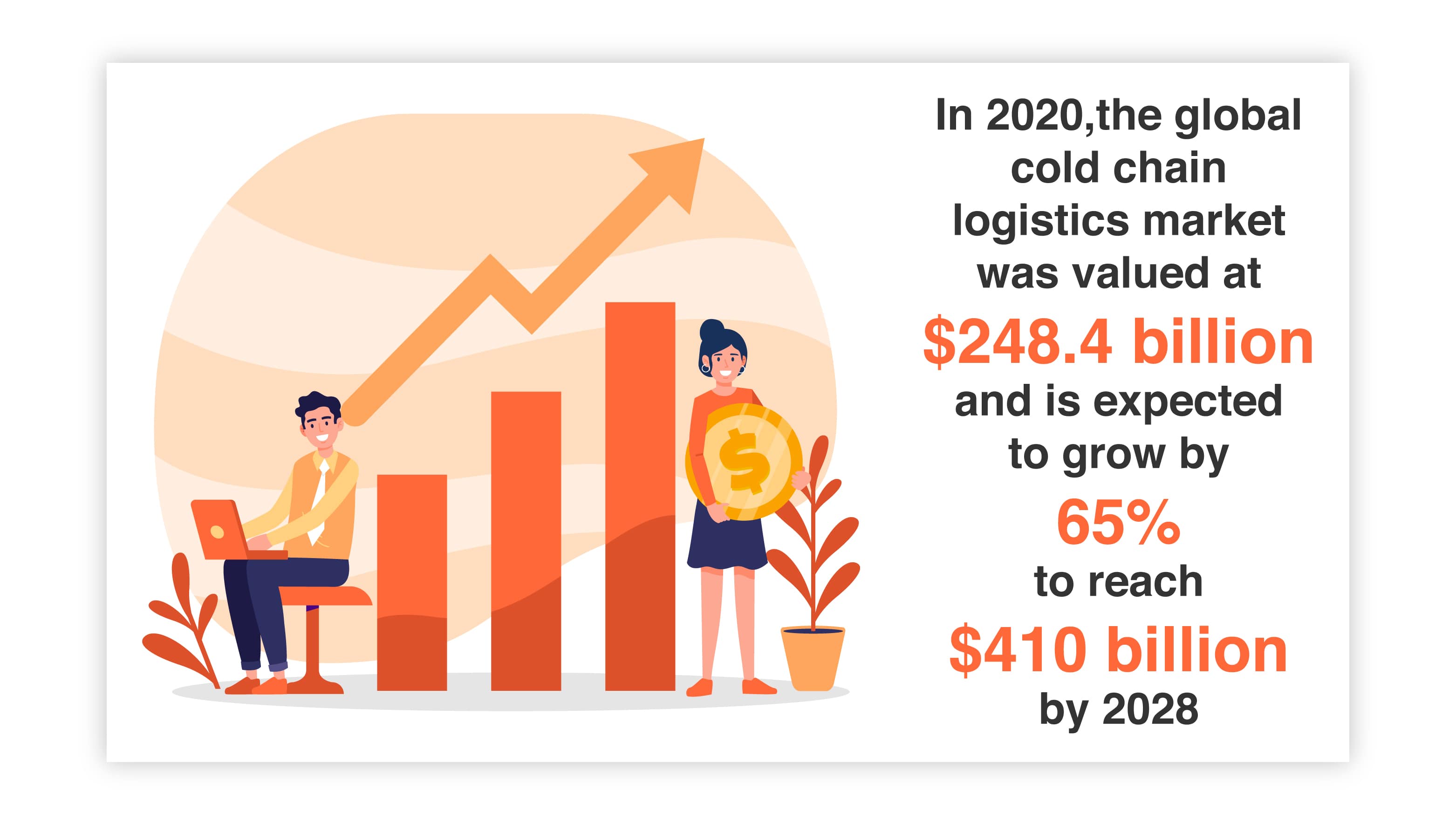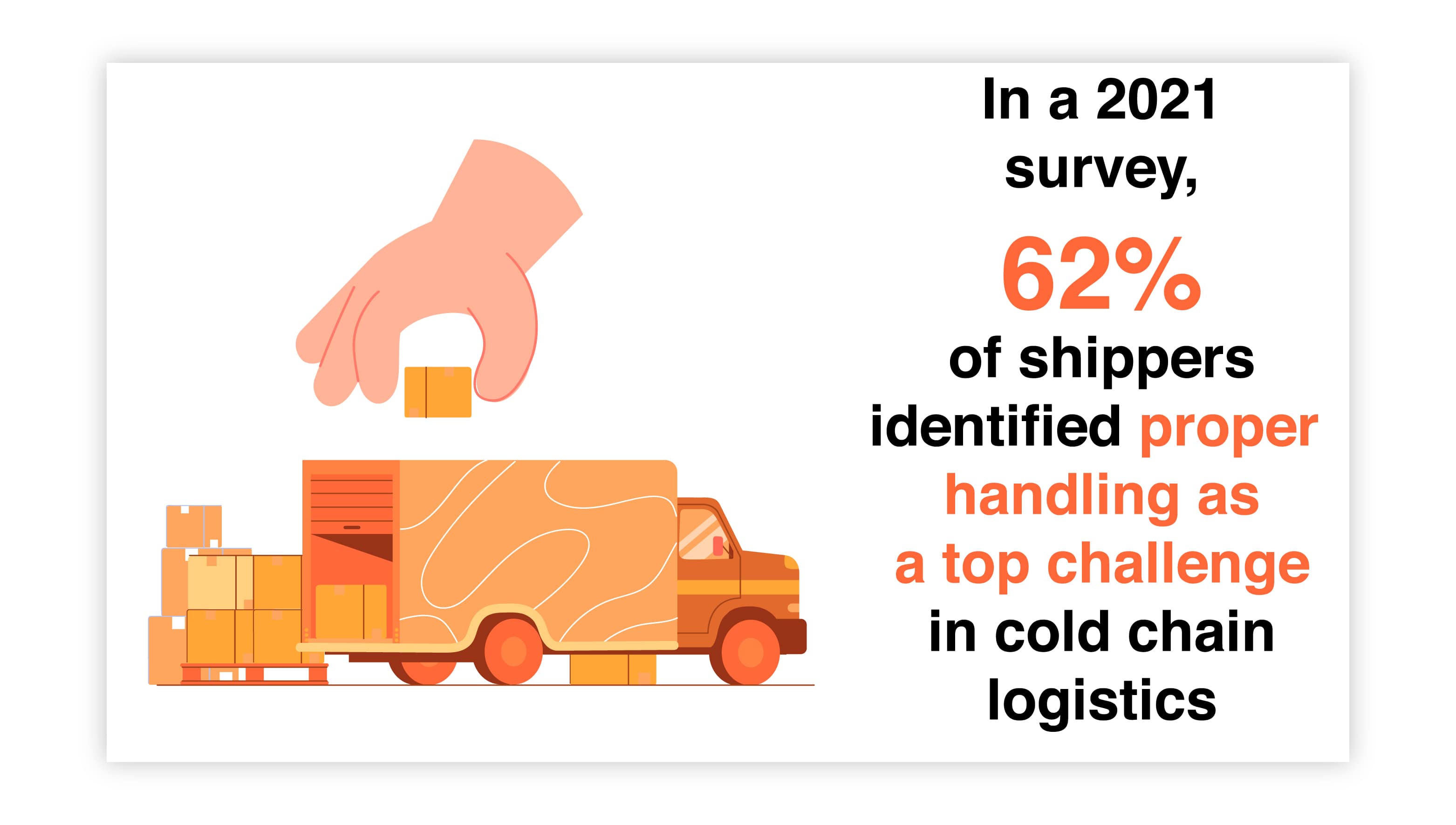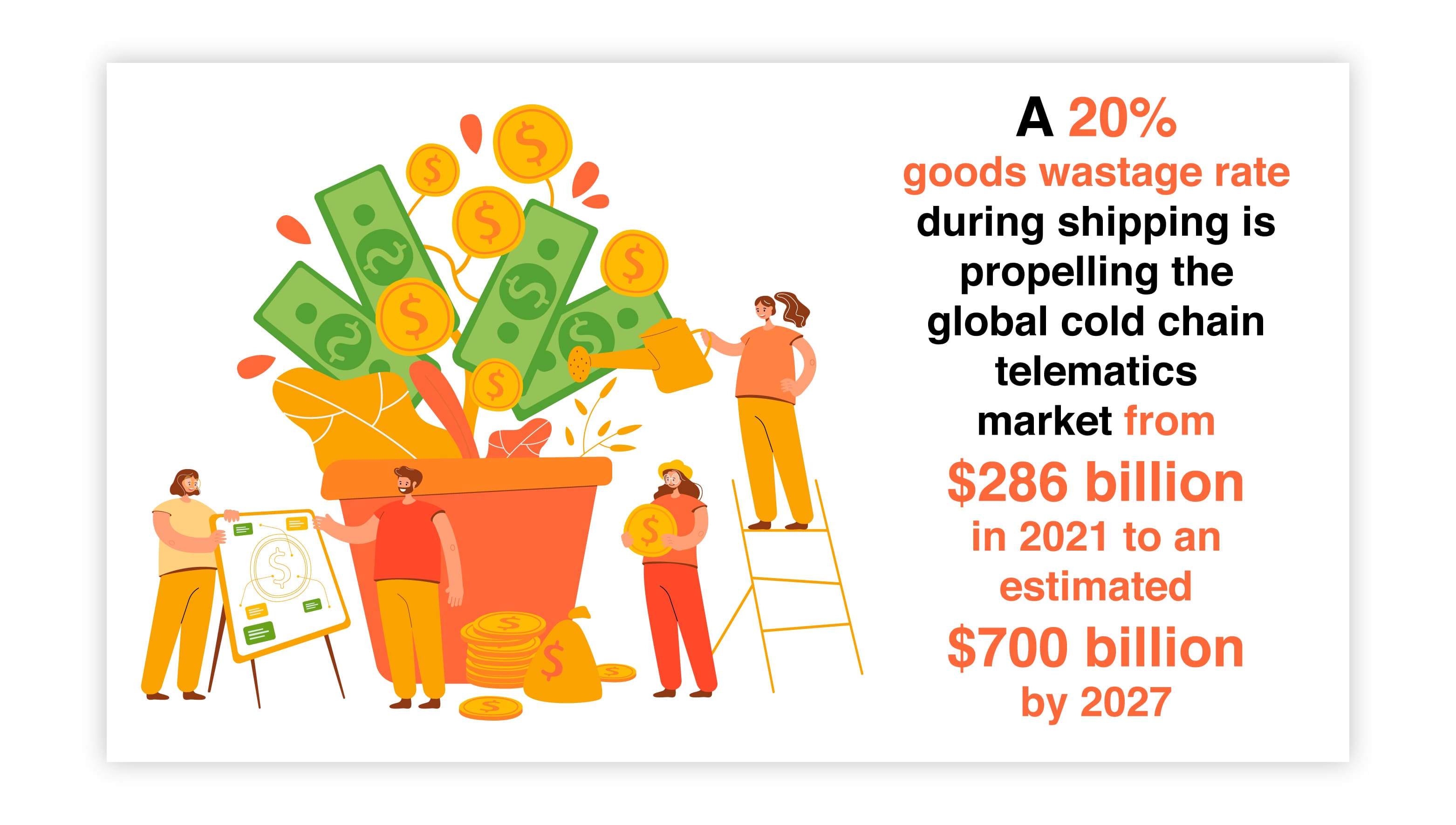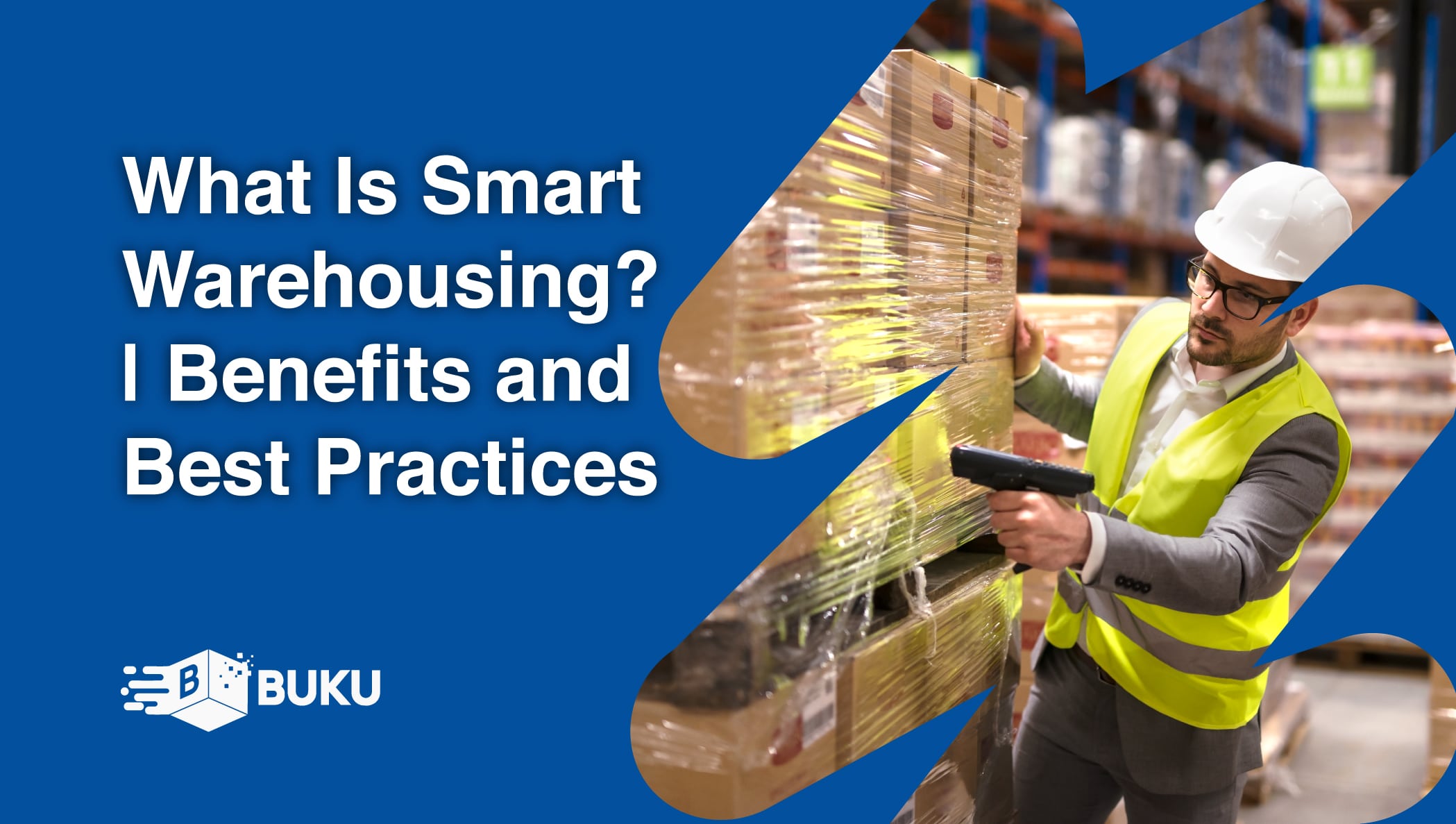Cold Chain Logistics: Management Challenges & Solutions
The supply chain is a term used to describe all the components required to transport goods from beginning to end, from production to the end...
9 min read
 BUKU Marketing
:
Sep 21, 2023 1:47:41 PM
BUKU Marketing
:
Sep 21, 2023 1:47:41 PM

The supply chain is a term used to describe all the components required to transport goods from beginning to end, from production to the end consumer. However, not all goods are created equal; some require special considerations throughout their journey.
Table of Contents
Cold chain logistics describes a supply chain that transports goods that require a temperature-controlled environment. Examples of these types of products are food, beverages, pharmaceuticals, and even flowers.
If your business deals in perishable products, you need stable cold chain logistics to ensure the product delivered to consumers is fresh and safe and maintains its quality throughout the journey.
Businesses have been working hard to rebuild and strengthen supply chains, spurred by the chaos of the past few years brought on by the COVID-19 pandemic.
Many realized they needed a more robust supply chain that could withstand any circumstance.
This is especially true for companies that deal with perishable goods, and cold chain logistics has become crucial for companies that wish to meet consumer expectations. Businesses could face astronomical losses if even one link in the cold chain collapses.
Add to this a pharmaceutical sector shipping vaccines globally at a rate never seen in history, and you have an exploding market segment. The global cold chain logistics market was worth $248.4 billion in 2020.
That market is expected to reach a value of $410 billion by 2028, a growth that represents a 65% increase since the start of the pandemic. It’s a growing segment ripe for innovation.

In this article, we will discuss cold chain logistics and touch on the component’s businesses should have in place to ensure the successful transportation of even the most perishable goods.
What happens when a supply chain breaks down? It’s simple – businesses can't transport goods from supplier to consumer. In most retail businesses, this presents a challenge. But for companies that deal with perishable goods, it's a potential catastrophe.
And the truth is, it doesn’t take a complete collapse of the supply chain to bring sales to a halt when it comes to perishables. Even minor errors during transfer or transportation can result in millions of dollars of spoiled product.
If a refrigerated truck carrying fresh food products breaks down, those food products will likely spoil and spoil quickly. The last thing businesses want is to deliver poor-quality goods to customers.
A survey conducted in 2021 found that 62% of shippers cite proper handling as one of the biggest challenges facing cold chain logistics.

Temperature monitoring also came in as a top concern. Both scenarios present significant challenges for businesses that deal in perishable goods.
Here’s a list of the top challenges facing cold chain logistics:
Temperature-sensitive goods require specialized equipment. From cold storage in warehouses to refrigerated trucks, this equipment maintains optimal temperatures for perishable products.
If that equipment breaks down, businesses could face incredible losses. Even a faulty seal on a refrigerator door can result in a drop in temperature, excess condensation, and even mold growth.
The supply chain can include one transfer of goods from warehouse to transport or several. Each time goods are transferred, it increases the risk of products being subjected to fluctuations in temperature and humidity.
While ordinary retail goods can sit on a loading dock for hours without problem, perishable goods cannot. And if less-than-quality products make it to customers, businesses face decreased customer satisfaction and a hit to their reputation.
The supply chain is a precarious balance of humans working with equipment and technology. Any mistake in the process can result in problems for cold chain logistics. Errors in scheduling and transportation can result in perishable goods being stranded somewhere.
Poor training of equipment and handling practices can have a similar lousy result. Each error along the way raises the risk of products ending up in bad shape and costing businesses a substantial amount of money.

Cost is always a consideration in business. Trying to maintain quality products from production to consumer is a challenge that will likely cost some dollars. However, it is essential for companies that deal with perishable products to build a robust and reliable supply chain.
Companies must optimize their cold chain logistics to protect the quality of their products and keep costs to a minimum. Here are some tips on how to build a cost-effective cold chain.

Technology can help companies gain better visibility and control over their supply chain. Better visibility means greater control and a head start on navigating potential crises as they arise. This helps companies mitigate risk and make better decisions when problems crop up.
Organization and careful project management is essential to any business. When it comes to cold chain logistics, it’s critical. Production schedules, transportation and shipping plans, delivery routes, and more must all meet in the middle – meaning everything needs to be carefully planned and scheduled to meet deadlines and demands.
Technology can bolster cold chains in several ways. Transportation management software is one example. This technology can help businesses optimize their transportation and delivery schedules, eliminating unnecessary handovers, expediting delivery routes, and minimizing the risk of products being exposed to extreme temperatures.
Businesses can use full truckloads (FTL) that are dedicated to their products alone or utilize less-than-truckload (LTL) deliveries. LTL shipping is a way for several shippers to share the space and the cost of shipping containers. Companies can lower their costs by focusing on smaller loads and finding other shippers with similar needs.
Streamlining warehousing processes is the first step to optimizing logistics. With the amount of freight that comes into and goes out of a warehouse, keeping everything in working order will help bolster efficiency and minimize problems. This is another place where technology, such as an integrated warehouse management system (WMS), can make a huge difference in operations.
The suppliers are among the most important links in any supply chain. Building relationships with suppliers and choosing only those suppliers who have experience and a trusted reputation puts companies in a better position all around.
Cold chain logistics requires specialized equipment to ensure products are kept at an acceptable temperature, from warehousing to last-mile delivery.
Companies can use many different types of equipment to protect goods along their journey. And other kinds of products require individualized environments.
Look at the categories of equipment commonly found in cold chains.
Perishable products must be kept in a temperature-controlled environment in storage and transit. Warehouses that handle cold goods might have cold storage or freezer rooms. Certain products might require sub-zero temperatures.
Some warehouses even come equipped with cold tunnels or corridors to maintain temperatures during transfer.
Perishable goods should also get special consideration when it comes to packaging. Insulated vacuum panels can insulate products during shipping.
Thermal bags and blankets provide insulation to help maintain the temperature of shipments. Susceptible products might be packed in air-tight containers and stored inside a secondary container to prevent leaks and maintain temperatures.
Goods can reach their final destinations by ground, sea, or air. No matter how temperature-sensitive goods are transported, there is equipment to get the job done right.
Refrigerated trucks, or “reefers,” protect goods during transit across land. Specialized cold-storage shipping containers protect goods as well.
Businesses can use sensors and moderators to monitor and track the temperature, humidity, location, and overall condition of goods during transit or storage. The most advanced sensors keep track of temperatures and humidity and can moderate the requirements if necessary.
According to statistics, 20% of goods are wasted during the shipping process, which might be why the global cold chain telematics technologies market is expected to reach a value of $700 billion by 2027, up from just $286 billion in 2021.

Building an infrastructure that supports cold chain logistics can help businesses gain real-time visibility into the condition of goods during storage or transport.
A network of IoT gateways and access points along the supply chain allows companies to collect and transmit data from sensors, giving them complete access and control over the efficacy and quality of their products.
The growth and advancements of automation, robotics, and other technologies have allowed businesses and industries to rethink and reframe their operations. Cold chain logistics has benefited from this technology in many ways.
Technology helps businesses be more efficient and accurate. It helps provide better visibility and control over the supply chain.
And it gives companies the tools to ensure perishable goods are delivered to customers' hands in a safe, responsible, and high-quality condition. Here are a few ways technology has elevated cold chain logistics processes.
Technology has transformed the modern warehouse. Technology plays a part in today's operations From the moment a shipment arrives until the very last item is loaded onto a truck. Automation allows for faster and more efficient inventory management and instantaneous record keeping.
The IoT, smart scanners and devices, and integrated management systems mean businesses have complete control over every aspect of operations.
Over the past decade, robotics has become one of the fastest-growing markets worldwide. The robotics market is expected to experience a CAGR of 10% and reach an estimated value of over $70 billion by 2028.

Cold chain logistics can use this innovative technology in warehouses, speeding handovers, and deliveries. The faster and more efficient a warehouse receives, stores, and retrieves products, the better.
When we think of payment automation, we typically picture everyday consumers purchasing goods online or at a brick-and-mortar store with little to no intervention.
Swipe a phone or log in with the click of a button, and payment occurs automatically.
Thanks to the rise of payment automation technology, businesses, shippers, and suppliers can now use this same technology. What results is a faster, more efficient process, eliminating the potential for human error and saving businesses time and money.
Another lesson learned from the Covid-19 pandemic is the importance of risk management and contingency planning.
Cold chain logistics requires a delicate balance and a solid partnership between businesses and suppliers.
However, companies must realize that their supply chain is at the mercy of circumstances often out of their control.
Risk management requires a company to take a long, hard look at its supply chain and identify all the possible problems that could halt operations.
A contingency plan allows businesses to address those problems before they arise and have an alternative plan in place just in case they need it.
For example, a natural disaster or political upheaval can make some land and sea routes unusable. If a company relies on those routes, they may suddenly find themselves with containers full of products and no way to move them, resulting in significant financial losses and unhappy customers.
During the pandemic, shipping and container costs skyrocketed, and many businesses found themselves where shipping containers were sitting at ports for weeks or months.
It was an unbelievable scenario for a company that deals with temperature or time-sensitive goods. These experiences have underlined the importance of risk mitigation.
Keeping perishable goods at the required temperature during transit is a major challenge of cold chain logistics. But businesses must also find ways to accomplish this task energy-efficient and sustainably if they expect to keep costs low and maintain a positive reputation. Here’s why it’s important:
Energy Efficiency is More Cost-Effective
Temperature-controlled warehouses, shipping containers, and vehicles require energy. Energy costs money. So, it makes sense for businesses to seek more energy-efficient practices in the supply chain and throughout their operations. Intelligent systems that monitor and adjust temperatures, energy-efficient HVAC systems, and even low-energy LED lighting can significantly impact a company's bottom line.
Optimizing operations and equipment to promote an energy-efficient supply chain will not only help companies keep costs down, but these technologies can help businesses preserve the quality and safety of their products throughout the supply chain.
Energy Efficiency is Expected
Today's consumer understands the importance of dealing with businesses that pride themselves on being ecologically friendly. And the government does, too. Sustainability is a topic of conversation throughout the world today.
Building a more energy-efficient supply chain contributes to a greener and more sustainable future by minimizing greenhouse gas emissions. Customers expect and value these priorities from the companies they do business with.
So far, we’ve discussed the importance of technology, equipment, and processes in optimizing cold chain logistics. But one component that a lot of businesses miss is the human component. Despite the rise of technology making its way into the supply chain, workers still play a massive role in the success of any business.
Eliminating Human Error
Employee training and skill development are essential for cold chain logistics. Consider the number of times an employee or worker comes in direct contact with goods or equipment: processing deliveries and shipments, transferring goods from warehouses to trucks, and making those critical last-mile deliveries.
Human error has the potential to derail even the most well-laid plans. And for companies that deal with perishable products, that could result in a costly outcome.

Empowering Employees
However, the benefits of employee training and development extend beyond just preventing costly errors.
Providing employees with an understanding of the importance of their role, the sensitive nature of the supply chain, and the company's expectations empowers them to perform better. And it motivates them to want to serve better.
Employees who are provided the tools to succeed take ownership of their roles. They can make quick and informed decisions that help protect the company’s assets. And they will be more efficient and productive, not to mention more likely to stick around long-term.
Food consumption and demand are at an all-time high worldwide. There is a growing demand for fresh, “farm-to-table" products, and consumers expect high-quality products delivered to their doorsteps quickly.
The same is true for retail businesses, who have faced product shortages and delays never seen before over the past few years.
When it comes to retail, the consumer holds the power. A business can do everything imaginable to keep costs low and optimize operations, but if the end customer isn’t satisfied,, all that work is in vain.
In today's digital era, it only takes moments for some information to go viral and destroy a company's reputation.
The Customer Expectation
Consumers today expect total transparency from the companies they do business with, including transparency in the cold chain logistics process. Today’s consumers are educated and informed, making decisions based on their knowledge.
They expect businesses to be responsible with their operations, including the supply chain, and they want to know precisely what is happening behind the scenes.
Technology solutions can play a part in bridging the gap between consumers and businesses by providing real-time track and trace software and warehouse management systems. Technology helps companies to ensure product safety and compliance.
Providing transparency helps to build trust and confidence in the end consumer.
A company that takes meaningful steps to make an honest and open reputation with customers will build a strong, positive reputation. Companies that fail in this task will suffer the consequences eventually.
Building a resilient and stable supply chain is critical for businesses, and it’s a complex process. Cold chain logistics is even more complex and challenging. But for companies who deal with perishable, temperature-sensitive products, it’s critical.
Both consumers and regulatory bodies demand complete compliance from companies that sell or transport these products. Perishable products must be delivered safely and responsibly. Consumers won’t be forgiven if they end up with low-quality products. And the government certainly won’t look kindly at a company that fails to follow the rules and provides unsafe products to the public.
By understanding the challenges that typically arise in cold chain logistics, businesses can implement effective solutions. Technology plays a huge role in mitigating risk for businesses like this, helping companies cut costs and be more efficient throughout the supply chain process. This will help build a cold chain that protects the company's assets and meets the consumer’s expectations.

The supply chain is a term used to describe all the components required to transport goods from beginning to end, from production to the end...

A smart warehouse is a large building where raw materials and other consumer goods are stored using machines, computers, comprehensive software, and...

Direct-to-consumer (DTC) fulfillment is a strategy that helps brands sell and deliver their products directly to customers more efficiently while...